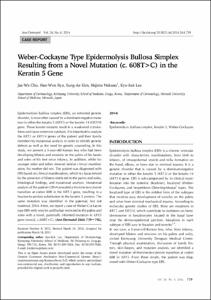Weber-Cockayne Type Epidermolysis Bullosa Simplex Resulting from a Novel Mutation(c. 608T>C) in the Keratin 5 Gene
- Keimyung Author(s)
- Cho, Jae We; Kim, Sung Ae; Lee, Kyu Suk
- Department
- Dept. of Dermatology (피부과학)
- Journal Title
- Annals of Dermatology
- Issued Date
- 2014
- Volume
- 26
- Issue
- 6
- Abstract
- Epidermolysis bullosa simplex (EBS), an inherited genetic disorder, is most often caused by a dominant-negative mutation in either the keratin 5 (KRT5) or the keratin 14 (KRT14) gene. These keratin mutants result in a weakened cytoskeleton and cause extensive cytolysis. It is important to analyze the KRT5 or KRT14 genes of the patient and their family members by mutational analysis in order to identify genetic defects as well as the need for genetic counseling. In this study, we present a 5-year-old Korean boy who had been developing blisters and erosions on the palms of his hands and soles of his feet since infancy. In addition, while his younger sister and father showed similar clinical manifestation, his mother did not. The patient was diagnosed with EBS based on clinical manifestation, which is characterized by the presence of blisters restricted to the palms and soles, histological findings, and mutational analysis. Mutational analysis of the patient's DNA revealed a thymine-to-cytosine transition at codon 608 in the KRT-5 gene, resulting in a leucine-to-proline substitution in the keratin 5 protein. The same mutation was identified in the paternal, but not maternal, DNA. Here, we report a case of Weber-Cockayne type EBS with vesicles and bullae restricted to the palms and soles with a novel, paternally inherited mutation in KRT5 gene (exon2, c.608T>C).
Keywords: Epidermolysis bullosa simplex; Keratin 5; Weber-Cockayne
- Publisher
- School of Medicine
- Citation
- Jae-We Cho et al. (2014). Weber-Cockayne Type Epidermolysis Bullosa Simplex Resulting from a Novel Mutation(c. 608T>C) in the Keratin 5 Gene. Annals of Dermatology, 26(6), 739–742. doi: 10.5021/ad.2014.26.6.739
- Type
- Article
- ISSN
- 1013-9087
- Appears in Collections:
- 1. School of Medicine (의과대학) > Dept. of Dermatology (피부과학)
- 파일 목록
-
-
Download
 oak-aaa-00279.pdf
기타 데이터 / 4.55 MB / Adobe PDF
oak-aaa-00279.pdf
기타 데이터 / 4.55 MB / Adobe PDF
-
Items in Repository are protected by copyright, with all rights reserved, unless otherwise indicated.